Archive for the ‘STORYSPACE’ Category
Wednesday, December 5th, 2007
My thanks again to Steve Ersinghaus for reminding me of the way to take screen shots in Windows so that I can not only add visual examples to this journal of how I wandered into Storyspace, but can share them on this weblog format (he also introduced me to blogging).
While none will see the copybook I also have kept as I’m writing this story, I am making sure that anything of any importance as to exploration and discovery is written about here.
Don’t know who reads this, but even if it’s just for myself, I have a complete record of the progress of the project, even–in old postings that I have to find and replace after wiping them off the weblog in a hissy fit–the very beginnings of Paths that was done as a "pseudohyperfiction" form. Via Copy & Paste, I’ve transferred all the posts into a Word.doc so that I can, as I did with New Media, print out a hard copy of all this as well.
That, I suppose, is where the traditional mingles with the new. Just like me.
Posted in STORYSPACE | Comments Off on STORYSPACE: The Journal and The Journey
Wednesday, December 5th, 2007
I’m just beginning really, but this is already so much better than before. This narrative form of “wholeness” — looking at the big picture you might say–is already improving the plot structure of Paths. Below is the new linkage that leads to what I’ll still call Story #4:
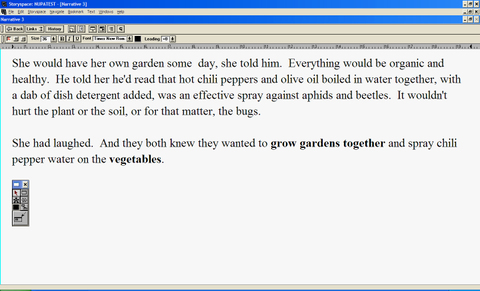
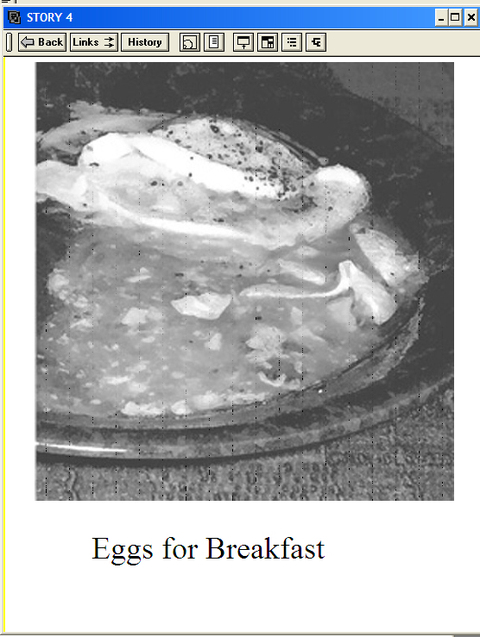
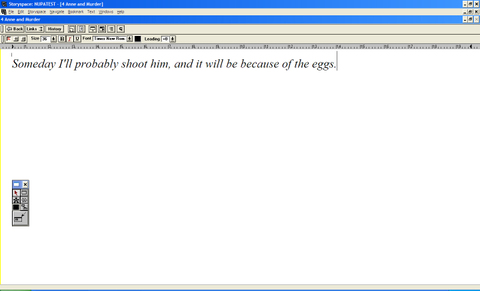
Posted in STORYSPACE | Comments Off on STORYSPACE: Structure – YES!
Tuesday, December 4th, 2007
Just a note here on what I’d like to see featured into any upgrades to the Windows version of Storyspace.
First and desperately needed is that "Do you want to save your work before you close?" box that is available in the Mac version but not in Windows. That just would remove so much of the fear of inadvertantly closing and losing between saves (as well as free up a couple pages of warnings in the manual). Though to be honest, it appears that if the program is inadvertently closed, when reopened it does look very similar to how it was closed–but that may just be because I’d recently ‘saved’ anyway.
Another almost imperative change would be the "promote children" command that’s again available in the Mac version only. This would have prevented an awful lot of hand-picking and rearranging for me in getting the Map View the way I later realized I needed it to be the best workable format. In so doing, it leads to the third area of concern.
Making the Map View make sense has affected the other Views. Now the Chart View is rather messed up but this depends on height of box on the view, etc. and I’m not sure that anything can be done to coordinate them. I think you need to decide which View you’re going to work with and stick with it regardless of what it does to the appearance of the others.
Overall, it’s an excellent and effective tool for hypertext writing. It’s user friendly, extremely easy to use and manipulate, and the manual has extremely good coverage and clear instruction. What the creators couldn’t realize at the time is how it affects the writer’s technique and style in composing narrative. This is likely an individualized benefit though I’m sure that much of it is shared in writer experience. And it’s all good.
Posted in STORYSPACE | Comments Off on STORYSPACE: Technical Notes
Tuesday, December 4th, 2007
Going back to Steve’s posting last night regarding the knowledge of character as influenced by environment, I agree completely that Storyspace, by its technical aspects of Writing Spaces and Mapping does bring an opportunity to develop characters in a different manner than traditional writing style.
What Steve terms as knowledge I might call faceting as well (why does Watchmen come to mind?). Visually, the Writing Spaces are acting as windows, or a “tell me everything about yourself in thirty seconds” to the writer. They are answers to the “oh, that’s why he did that,” about a character. They form natural breaks of paragraph and thought, often encouraging another window to open, just as often pulling the shade down as a conclusion to a question. The writer is being encouraged to question any sequence of the narrative as it unfolds. He can then share what he learns via a loop or thread of Writing Spaces.
The Spaces also influence the pacing of story. Just as short sentences increases dramatic action, the spaces allow a rat-a-tat-tat of information or a slow revelation of a hidden spirit.
In the manner of a new acquaintance, we find out bits and pieces of our characters by their thoughts, their actions, enclosed in separate boxes that are ever-ready to hold this secret or that.
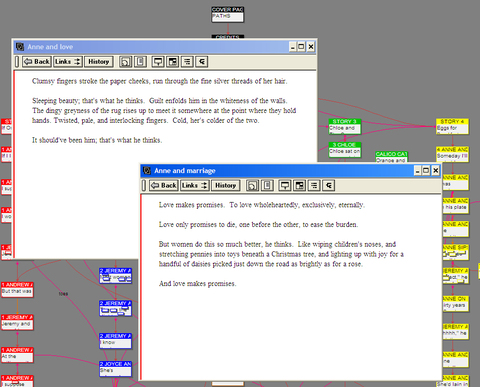
Posted in STORYSPACE | Comments Off on STORYSPACE: Character Development
Tuesday, December 4th, 2007
Went to bed. The thought wouldn’t go away. Does structure of narrative indicate anything of the personality of an author?
We see this in literature all the time, the influence of the experience of the writer on the story. But with the maps and charts of Storyspace, do we see more, even as we propose the means of hypertext as a more reader based work?
I can’t sleep because of the strictness of the five rows of story, evenly spaced, color-coded. What have I revealed about myself? Anal retentive? I am hoping for logical and organized if such things can be determined from Storyspace’s Map View at all.
A thought creeps in, my salvation, perhaps: The stories will be connected to the mainline and each other in loops. It is in my power to arrange the writing spaces to reflect that, as one story flows from the main path, travels a bit and returns, only to lie dormant for a few more spaces until it flows outward again. This Map View would look more like a blade of swamp grass with bubbles of frog eggs billowing out down its length. And I will look more free-spirited. That is, if I can take myself out of square.
Posted in STORYSPACE | Comments Off on STORYSPACE: Personality
Tuesday, December 4th, 2007
This is a portion of the latest Map View where I have all five trails laid out side by side (with just a few of the ‘children’ or side trails pulled out) and this, I think, is where I’ll find it easiest to work with link connections. It will also allow for the expansion of story and character that seems to be a phenomenon of the Storyspace environment not as easily offered or noticed in traditional writing methods (or at least by me). Steve notes this element in his post on Hypertext and Character. (Semantically proper link here!)
What this particular structure has already allowed me to do is find a starting point in the central narrative for each of the four paths to begin. Since the entire reading layout will now be focused on a single starting point that includes the interweaving of the four (instead of the prior separation of starting points with random connecting links), where the stories touch and interplay with each other is a matter of locating natural ‘touching’ points of narrative. Sort of like one thought sparking another.
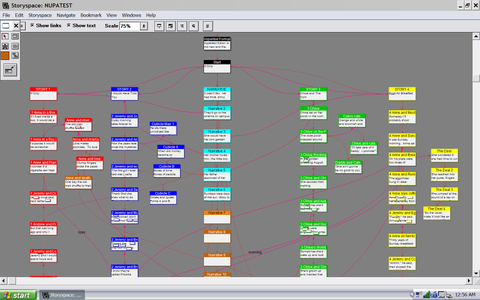
Posted in STORYSPACE | Comments Off on STORYSPACE: All Paths Lead Home
Monday, December 3rd, 2007
I’m having a helluva time here, on about the fourth ‘version’ of Paths, now it looks like the best method of doing this is in Map View, and the hell with what Chart and Outline and Tree look like. Though what I’m doing can certainly be done in Chart or Outline, the links won’t show up and I won’t have a purdy pit’cher of the layout in Map View.
The bigger problem: How to pull out all those children from their parents so that all the trails are out on one map instead of each story on a separate one. It looks like I may have to try yet another version and start from scratch because it doesn’t look like I can find twenty spaces and pull them out if I can’t see them. If I open the mother space, I can see them, but can’t take them out. The other option is to make that change via the chart view and then go back to map and work in there.
Posted in STORYSPACE | 2 Comments »
Sunday, December 2nd, 2007
It took a while to solidfy from the fog, but there seems to be a logical progression of narrative happening now that is closer to the general idea of the stories, and to the work as a whole.
Basically there is a main narrative that is a sort of story in itself. At certain points in the narrative, there are text links that lead off to the beginning of each of the original four stories. Once on the path of a story, a reader will follow this thread, being able to go off on some of the relative text links particular to that story, and eventually will be returned to the main thread, either back to the place from which he left, or to the very next space. This ensures that no opportunity is lost. Eventually, another text link will take him off to the story where he left off, although in the meantime, he may have ‘visited’ other story threads as well.
I’m working it in the Chart View right now, with the hard copy as script, but will post a Map View to show the links as soon as I can figure out how to get the Map View of each story unloaded into one big picture.
Posted in PROJECTS, STORYSPACE | Comments Off on STORYSPACE & PROJECTS: Natural Trails
Sunday, December 2nd, 2007
Oooh–oooh—oooh! I think the project is forming a structure. I can see that with a vague path that’s relative to all the stories yet not specific to any one, a path that’s actually a comment on society of the 70’s in its amalgam, it offers a multitude of openings. Doorways. Links.
What the building blocks of Writing Spaces are starting to do is form itself into a small town. Main Street is for every man and every day travel. The side streets run off to suburbia, the mountains, the docks. I see a systematic and practical structure that can support past, present and dreams alike.
Posted in STORYSPACE | Comments Off on STORYSPACE: Architectural Story Form
Sunday, December 2nd, 2007
It could be the quiet cold of a coming snow, the waiting out as if for a package in the mail. The hushed anticipation that bursts out in unanticipated ways; riding around like an Indian brave, warpaint as bold as the wild Pinto he commands with his thighs.
I’m writing like it’s my last will and testament and the final draft is due by midnight.
Posted in STORYSPACE | Comments Off on STORYSPACE: Imagination in a box






 The Lost Children: A Charity Anthology
The Lost Children: A Charity Anthology